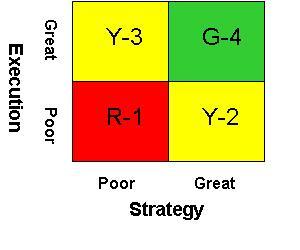The January 29, 2009, Wall Street Journal had an article “CEO’s Debate: Execution vs. Strategy” that caught my attention. Many prominent CEO’s were asked, “What’s more important: strategy or execution?”
These are not mutually exclusive choices. Both have a profound bearing on the overall success of an organization. Consider the following matrix:
- G-4 is where a company wants to be: great strategy and great execution.

- R-1 is the least desirable position to be in: poor strategy combined with poor execution—unless action is taken, a company in this state is headed for extinction.
- Y-2 indicates that a company is poorly executing a great strategy suggesting there are opportunities for process improvements to support better business execution.
- Y-3 indicates that a company is doing a great job executing a poor strategy suggesting the marketplace is not impressed with the company’s offerings in spite of the fact it is executing well—this does not bode well for the continued health and vitality of the company.
Few companies achieve the state described in G-4. Even if a company is experiencing great strategy and great execution, there is certainly no guarantee that it will continue to experience this.
One thing is clear: A company in a state other than G-4 puts executives at risk for losing their jobs and puts employees continued tenure at risk as well.
Let’s rate some companies that are household names:
- General Motors: R-1 for poor strategy and poor execution
- Apple: G-4 for great strategy and great execution
- Oracle: G-4 for great strategy and great execution
- Sun: Y-2 as one must assume that there is great value in Sun’s intellectual property (over $7 billion) that makes Oracle and IBM interested in acquiring them; the larger issue has to be execution
Many years ago, one of the most admired Silicon Valley companies was Silicon Graphics, a company that produced graphic workstations that enabled the creation of the blockbuster movies such as “Jurassic Park,” “Terminator,” and others. CNET News reported on April 1, 2009, that SGI was being sold for “a paltry $25 million.” The article goes on to say:
“When a one-time tech powerhouse winds up bankrupt and sold off for chump change, that’s bound to ignite the daily bloviation fest….SGI was a comet, soaring through the tech firmament during it’s brief moment of glory. But it’s only one in a list of former high-tech flyers to come crashing back to earth, a roster that includes the likes of Novell, Borland, WordPerfect, Digital Equipment Corporation, Wang, Data General.”
Charles Cooper, the author of the CNET article, aptly includes thoughts from Andy Grove who wrote the following in his 1996 book, Only the Paranoid Survive:
“…when it comes to business, I believe in the value of paranoia. Business success contains the seeds of its own destruction. The more successful you are, the more people want a chunk of your business and then another chunk and then another until there is nothing left.”
In its heyday, Silicon Graphics was like the Apple of today. In a few short years, it moved from “great execution/great strategy” (G-4) to “great execution/poor strategy” (Y-3) to “poor execution/poor strategy” (R-1) ultimately taking it to bankruptcy.
Where do most CEOs focus their attention? Strategy. It is as though the CEO expects the rest of the leadership team to drive execution. At the end of the quarter or fiscal year, what area most contributes to CEOs losing their jobs? Execution.
While it is possible to pick a place on the matrix that reflects the overall company state, it is important to also consider each function in the company in light of this same matrix, e.g., Sales, Marketing, Product Management, Order Administration, Engineering, Operations, Service, Human Resources, etc.
Executives must regularly and routinely look holistically at the implications of each function as contributing to the overall health and vitality of the company. Today’s success does not ensure tomorrow’s success.
What do you think?
Dave Gardner, Gardner & Associates Consulting
http://www.gardnerandassoc.com
I fully agree. We must abandon yesterday. We can no longer rely on yesterday’s success model.
The question is what must leaders do different to perform in G-4. Leaders get it.
Leaders know that a titanic mistake has been to focus more on crafting strategy than implementing it. It is not a hard sell and the arguments in the past decade combined with their staggering failure to deliver on their strategy promises, have led to strategy implementation becoming an integral part of discussions today.
Leaders now want to know what to do. The question leaders are now asking is “What do we need to do differently?” Too many leaders on too many occasions have been involved in too many failures. Research has piqued their curiosity. We have provided a solid argument and followed that by building the platform to move forward from failing frequently to resolving challenges. Leaders can now know specifically what to do to successfully drive strategy implementation through their organizations.
Something needs to change and it starts with the leaders. Attitude, approach and actions must change. Many actions leaders need to take to successfully implement strategy are contrary to current beliefs. One belief: most people resist implementation (but not when it is communicated correctly). Another belief: strategy implementation must be reviewed twice a year (no, it should be reviewed every two weeks).
Today, implementation can’t simply be delegated. Instead, leaders must spend the majority of their time overseeing the implementation actions – it’s that critical to successful implementation.
Key actions leaders must take.
• Change daily dialogues from operations to strategy implementation
• Identify the “Strategy Customers”
• Focus on mavericks
• Brand the strategy
• Be the “Voice of the Strategy”
• Change the strategy, change the measures
• Recognize that culture does not drive strategy but does drive implementation
• Abandon yesterday more quickly than ever before
• Identify behaviors and actions staff members should stop doing
• Review implementation progress every two weeks
• Say “thank you”
LikeLike